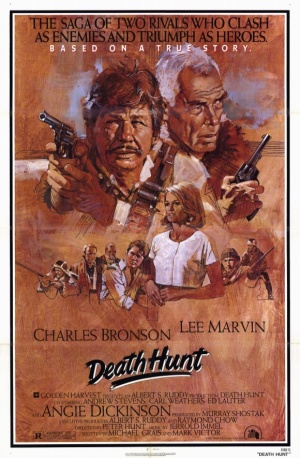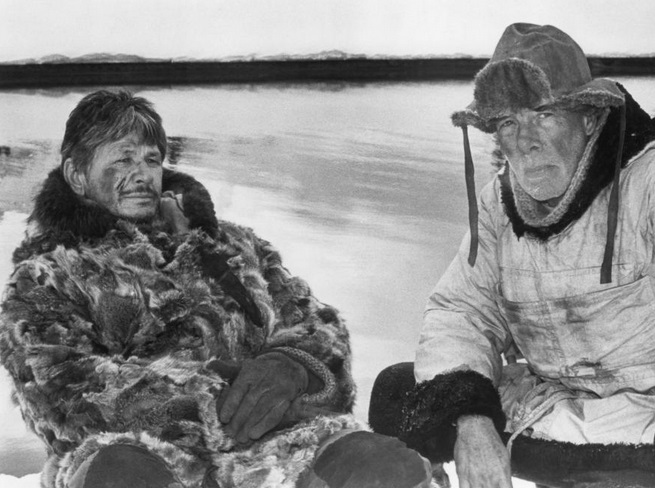
“That look on your face would turn good whiskey into sour piss.”

Death Hunt, 1981 (Charles Bronson), 20th Century Fox
“This motion picture is based on a true story” is written in schlocky big-and-bold red titles; Charles Bronson is Death Hunt – not quite, but wouldn’t it be cool if his given Christian name were, indeed “Death J. Hunt”, or whatever? I mean, talk about the coolness factor. Here we are in the wild, white Yukon with some splendid Steadicam-aerial photography and we’re thrust into a literal dog-fight. The year is 1931, so it’s probably not illegal yet. Bronson runs afoul of the locals involved when he rescues one of the dogs involved. You get that steely-eyed Bronson trademark gaze. He gives the owner (the great character actor Ed Lauter) $200 for the wounded dog and leaves.
Lauter isn’t having any of it. He takes up arms with an Alaskan version of a posse (among them Carl “Apollo Creed”/”Action Jackson” Weathers, William Sanderson, and Maury Chaykin) to apprehend Bronson. Bronson nurses the dog back to health, feeds him and bonds with him. The heavies case Bronson’s hunting shack, but he is ready for them, and he plugs one of them. Lauter alerts the authorities (in this case, Mounties Andrew Stevens and Lee Marvin, who knows Lauter is lying) and they lead the hunt for the so-called “Mad Trapper”.
The movie’s story depends on Bronson staying one step ahead of his pursuers, which he does with aplomb. He is skillful and resourceful, but unfortunately an act of self-defense is added to his perceived list of crimes. It’s amazing to me (looking at the movie now) how quickly this narrative moves. We have to remember, the movie was made at a time when action/adventure movies didn’t have to be nonsensical, bloated epics. The editing is lean, action-oriented and economical. The scenes between Marvin and Bronson ooze testosterone. Both men have desperation in their eyes. Marvin wants an end to the violence. Bronson just wants to be left alone.

When Marvin and Stevens’ caravan of vengeance-minded soldiers set out to capture the Trapper, he rigs his property with booby-traps, digs a trench in the middle of his cabin, and positions his guns at strategic points. The Peckinpah-inspired scenes of violence are well choreographed, and the liquored-up, tense dialogue of Lauter’s posse is hilarious. Marvin’s character is lost in his own idealistic past while Stevens represents a future of two-way radios and explosives.
The men constantly put each other through frenetic games of machismo, and all Bronson can do is shake his head and listen to their endless tirades. In the middle of the long Alaskan night, they blow up his cabin with dynamite, and he is forced to take to the snow, but not before cutting down most of them. Ultimately, the posse divide into separate groups, so that they don’t have to split the reward money. They kill each other off as a result of their incompetence until it finally comes down to Marvin and Bronson.
Charles Dennis Buchinsky appeared in House of Wax with Vincent Price. His first lead role was in Roger Corman’s Machine-Gun Kelly. He became a ubiquitous presence in revenge fantasies, starting with Michael Winner’s Death Wish (spawning four sequels), Hard Times as well as becoming a staple for Cannon Films (along with Chuck Norris) with 10 to Midnight, Murphy’s Law, and Kinjite: Forbidden Subjects.
Our first cable box was a non-descript metal contraption with a rotary dial and unlimited potential (with no brand name – weird). We flipped it on, and the first thing we noticed was that the reception was crystal-clear; no ghosting, no snow, no fuzzy images. We had the premium package: HBO, Cinemax, The Movie Channel, MTV, Nickelodeon, CNN, The Disney Channel, and the local network affiliates. About $25-$30 a month. Each week (and sometimes twice a week!), “Vintage Cable Box” explores the wonderful world of premium Cable TV of the early eighties.
Leave a comment